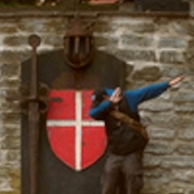 Gerhardt
GerhardtTRUE OR FALSTHE HISTORY OF THE IDITAROD – THE LAST GREAT RACE ON EARTHIn the 1880s, gold was discovered in what is now the most northern state of the USA, Alaska. Many people came to the area hoping to get rich. New towns were built and grew quickly. One such town was called Iditarod, which means ‘far, distant place’. This town grew so quickly during 1909 that it briefly became the largest city in Alaska. In the summer months, essential supplies could be delivered to these towns by boat, but in the winter the rivers and the ocean froze and there was no way to get to them. So, in 1910, a winter track was built which would be used by teams of dogs pulling sleds. They would take mail, food and clothes to the gold miners. The track became known as the Iditarod Trail. It took a team of dogs about three weeks to travel across Alaska. They stopped at ‘roadhouses’ where the drivers could get a warm bed for the night and something to eat for both themselves and their dogs. The trail was used every winter until the 1920s when aeroplanes replaced steam boats and dog teams as the main form of transport. However, the dogs had one last taste of fame in 1925, when a disease called diphtheria hit the city of Nome. The disease could be cured, but, unfortunately, the closest medicine that could be found was in Anchorage, right on the other side of Alaska. Aeroplanes were still quite new, so no-one knew if they could fly in such cold weather. Also, Carl Eielson, the only pilot considered skilled enough to manage flight, was away on a trip at the time. It was therefore agreed that the medicine would be transported using teams of dogs instead. The trip covered over 1,000 kilometres, most of it along the Iditarod trail. It took twenty teams just six days to complete the journey. Leonhard Seppala, a Norwegian who had come to Alaska looking for gold, travelled the first 400 of those kilometres. He had to trust his dog Togo`s ability to find his way in the blinding snow and Togo turned out to be a reliable guide. The last part of the journey was done by Gunnar Kaasen who had driven dog teams in Alaska for 21 years. His lead dog was Balto. At one point Balto refused to go any further, and saved the team from falling into icy water. The diphtheria was stopped and Balto became a hero. Nowadays a dog sled race is held every year from Anchorage to Nome, following the route of that famous journey in 1925. It is called the Iditarod and has become known as ‘The Last Great Race on Earth’. 1. The population of Alaska remained the same throughout the 1880s. 2. For a short time, more people lived in Iditarod that in any other city in Alaska. 3. After 1910, it became possible to deliver letters in winter as well as summer. 4. When travelling on The Iditarod, drivers had to take food for the dogs with them. 5. In the 1920s, aeroplanes were used more often than boats and dogs. 6. Doctors in Nome had a good supply of medicine to cure diphtheria. 7. The pilot Carl Eielson refused to fly his plane because of the cold weather. 8. Leonard Sappala’s dog was able to lead him safely to his destination. 9. Balto fell into some icy water but managed to save himself. 10. The Iditarod race takes a different route every year.
ответы: 1
Зарегистрируйтесь, чтобы добавить ответ
Чтобы ответить необходимо зарегистрироваться.